Indigenous Health: Culturally Safe Environment in Healthcare - Report
VerifiedAdded on 2023/01/18
|8
|1688
|23
Report
AI Summary
This report addresses the critical issue of culturally safe environments in healthcare settings, particularly focusing on the care of a 58-year-old Aboriginal man with diabetes admitted to an emergency department. It outlines a culturally safe care process encompassing building relationships, effective communication, health education, and culturally sensitive treatment. The report emphasizes understanding the patient's historical and cultural background, language preferences, and traditional beliefs to provide holistic care. Methods for delivering culturally safe care, such as non-threatening body language, language interpretation, and incorporating family involvement, are detailed. The report analyzes three videos and an audio podcast, highlighting historical injustices, socio-economic disparities, and systemic biases faced by Indigenous populations in healthcare, underscoring the need for culturally competent practices to address these challenges and improve health outcomes. The references provides further insights into the topic.
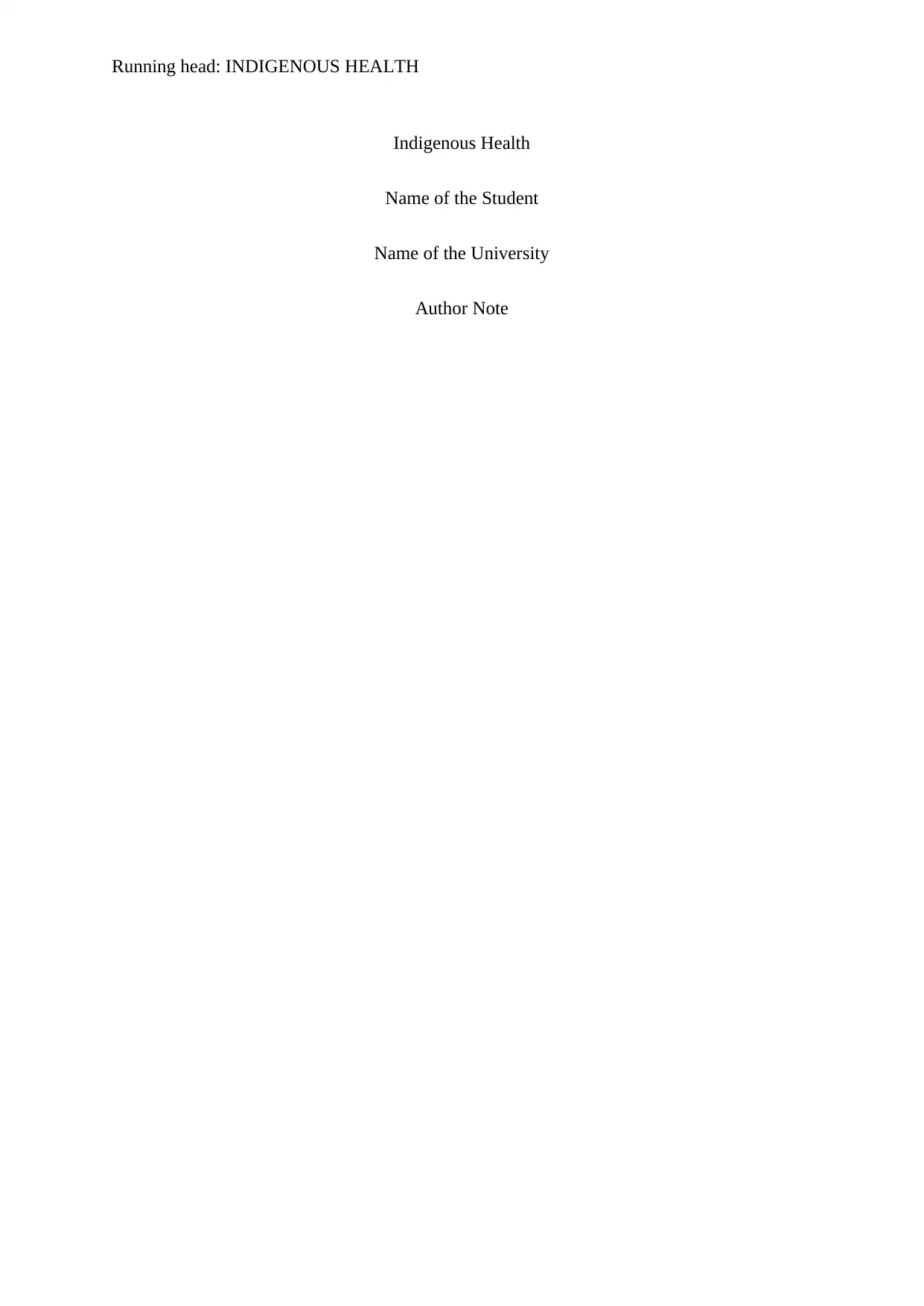
Running head: INDIGENOUS HEALTH
Indigenous Health
Name of the Student
Name of the University
Author Note
Indigenous Health
Name of the Student
Name of the University
Author Note
Paraphrase This Document
Need a fresh take? Get an instant paraphrase of this document with our AI Paraphraser
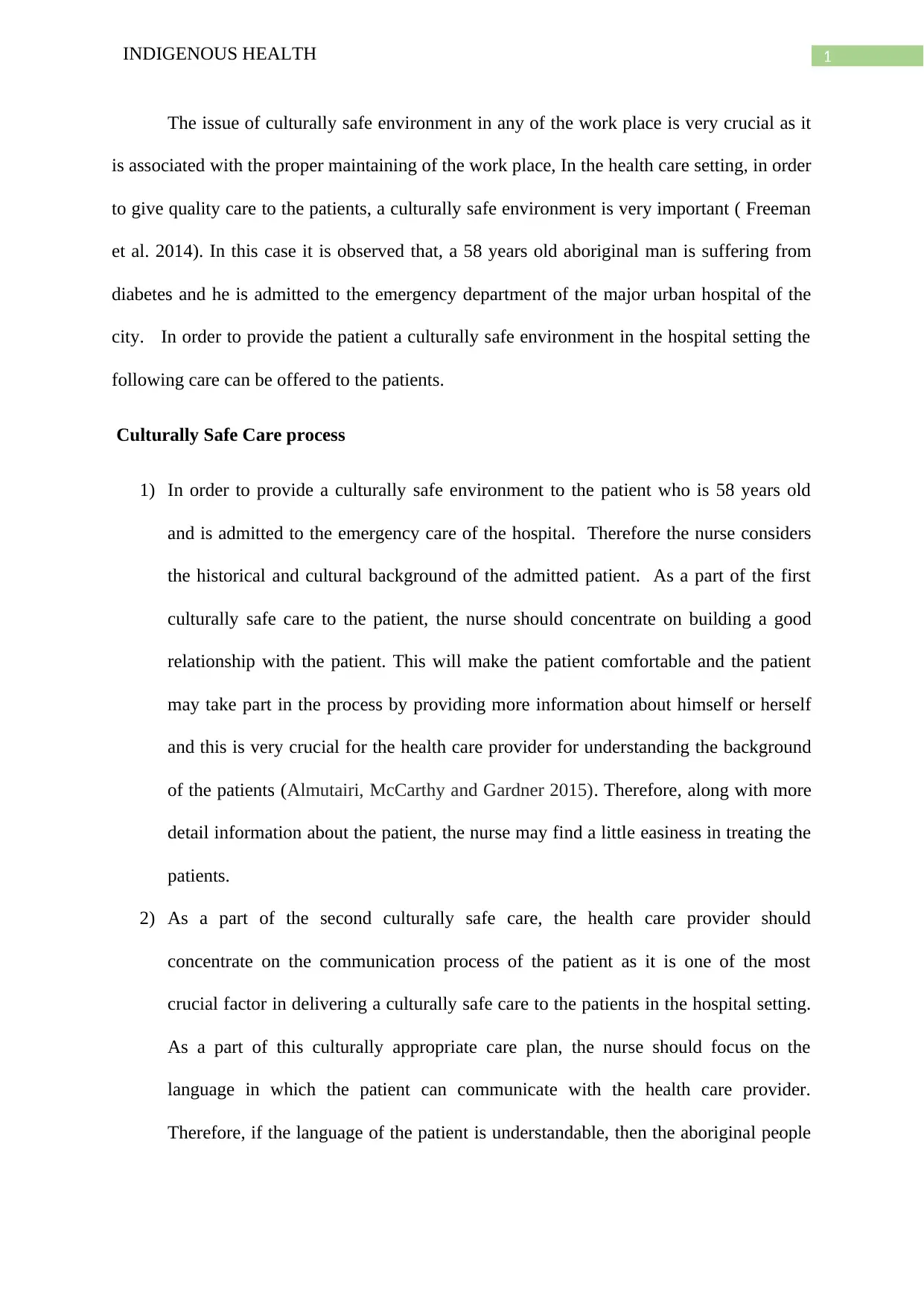
1INDIGENOUS HEALTH
The issue of culturally safe environment in any of the work place is very crucial as it
is associated with the proper maintaining of the work place, In the health care setting, in order
to give quality care to the patients, a culturally safe environment is very important ( Freeman
et al. 2014). In this case it is observed that, a 58 years old aboriginal man is suffering from
diabetes and he is admitted to the emergency department of the major urban hospital of the
city. In order to provide the patient a culturally safe environment in the hospital setting the
following care can be offered to the patients.
Culturally Safe Care process
1) In order to provide a culturally safe environment to the patient who is 58 years old
and is admitted to the emergency care of the hospital. Therefore the nurse considers
the historical and cultural background of the admitted patient. As a part of the first
culturally safe care to the patient, the nurse should concentrate on building a good
relationship with the patient. This will make the patient comfortable and the patient
may take part in the process by providing more information about himself or herself
and this is very crucial for the health care provider for understanding the background
of the patients (Almutairi, McCarthy and Gardner 2015). Therefore, along with more
detail information about the patient, the nurse may find a little easiness in treating the
patients.
2) As a part of the second culturally safe care, the health care provider should
concentrate on the communication process of the patient as it is one of the most
crucial factor in delivering a culturally safe care to the patients in the hospital setting.
As a part of this culturally appropriate care plan, the nurse should focus on the
language in which the patient can communicate with the health care provider.
Therefore, if the language of the patient is understandable, then the aboriginal people
The issue of culturally safe environment in any of the work place is very crucial as it
is associated with the proper maintaining of the work place, In the health care setting, in order
to give quality care to the patients, a culturally safe environment is very important ( Freeman
et al. 2014). In this case it is observed that, a 58 years old aboriginal man is suffering from
diabetes and he is admitted to the emergency department of the major urban hospital of the
city. In order to provide the patient a culturally safe environment in the hospital setting the
following care can be offered to the patients.
Culturally Safe Care process
1) In order to provide a culturally safe environment to the patient who is 58 years old
and is admitted to the emergency care of the hospital. Therefore the nurse considers
the historical and cultural background of the admitted patient. As a part of the first
culturally safe care to the patient, the nurse should concentrate on building a good
relationship with the patient. This will make the patient comfortable and the patient
may take part in the process by providing more information about himself or herself
and this is very crucial for the health care provider for understanding the background
of the patients (Almutairi, McCarthy and Gardner 2015). Therefore, along with more
detail information about the patient, the nurse may find a little easiness in treating the
patients.
2) As a part of the second culturally safe care, the health care provider should
concentrate on the communication process of the patient as it is one of the most
crucial factor in delivering a culturally safe care to the patients in the hospital setting.
As a part of this culturally appropriate care plan, the nurse should focus on the
language in which the patient can communicate with the health care provider.
Therefore, if the language of the patient is understandable, then the aboriginal people
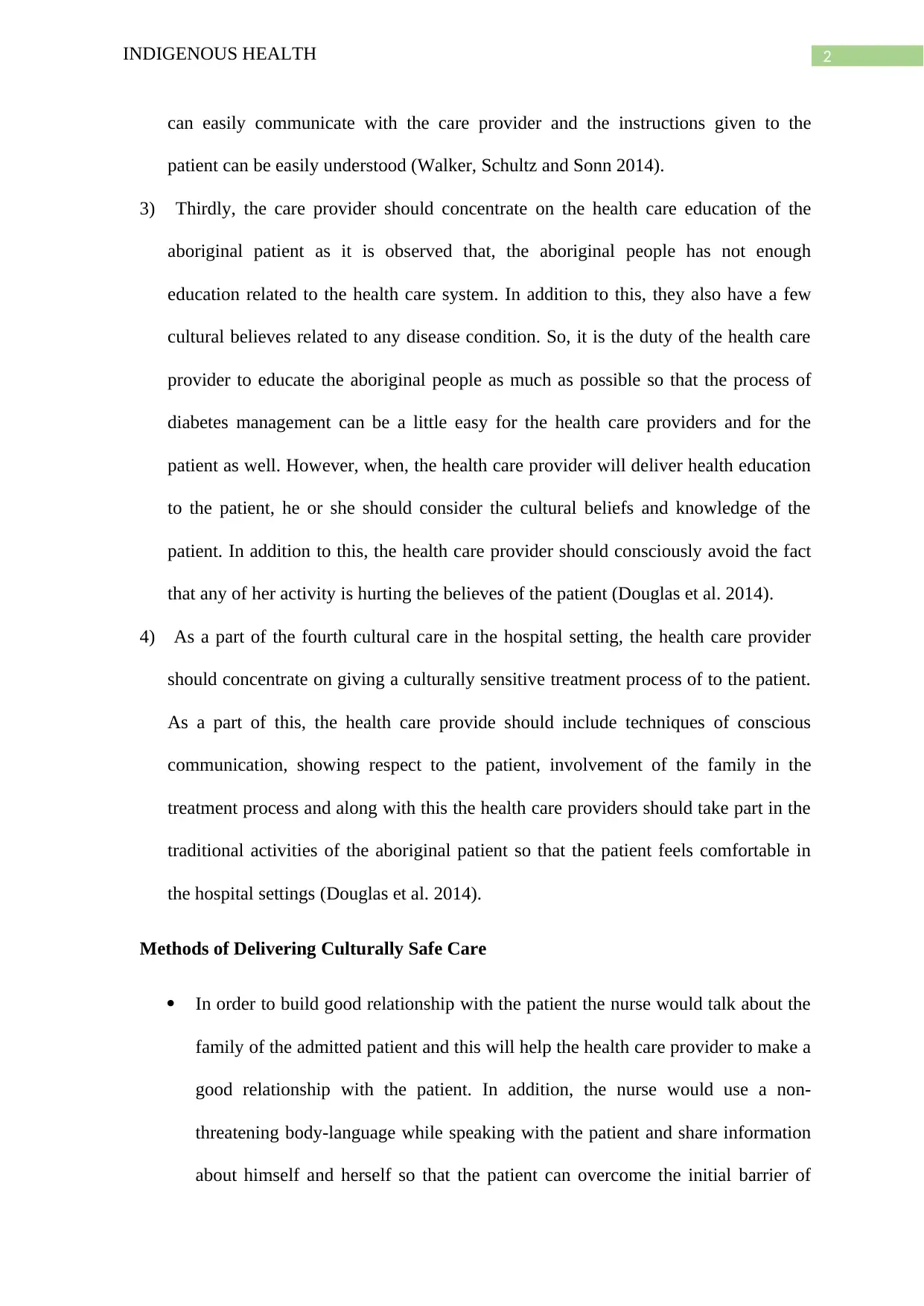
2INDIGENOUS HEALTH
can easily communicate with the care provider and the instructions given to the
patient can be easily understood (Walker, Schultz and Sonn 2014).
3) Thirdly, the care provider should concentrate on the health care education of the
aboriginal patient as it is observed that, the aboriginal people has not enough
education related to the health care system. In addition to this, they also have a few
cultural believes related to any disease condition. So, it is the duty of the health care
provider to educate the aboriginal people as much as possible so that the process of
diabetes management can be a little easy for the health care providers and for the
patient as well. However, when, the health care provider will deliver health education
to the patient, he or she should consider the cultural beliefs and knowledge of the
patient. In addition to this, the health care provider should consciously avoid the fact
that any of her activity is hurting the believes of the patient (Douglas et al. 2014).
4) As a part of the fourth cultural care in the hospital setting, the health care provider
should concentrate on giving a culturally sensitive treatment process of to the patient.
As a part of this, the health care provide should include techniques of conscious
communication, showing respect to the patient, involvement of the family in the
treatment process and along with this the health care providers should take part in the
traditional activities of the aboriginal patient so that the patient feels comfortable in
the hospital settings (Douglas et al. 2014).
Methods of Delivering Culturally Safe Care
In order to build good relationship with the patient the nurse would talk about the
family of the admitted patient and this will help the health care provider to make a
good relationship with the patient. In addition, the nurse would use a non-
threatening body-language while speaking with the patient and share information
about himself and herself so that the patient can overcome the initial barrier of
can easily communicate with the care provider and the instructions given to the
patient can be easily understood (Walker, Schultz and Sonn 2014).
3) Thirdly, the care provider should concentrate on the health care education of the
aboriginal patient as it is observed that, the aboriginal people has not enough
education related to the health care system. In addition to this, they also have a few
cultural believes related to any disease condition. So, it is the duty of the health care
provider to educate the aboriginal people as much as possible so that the process of
diabetes management can be a little easy for the health care providers and for the
patient as well. However, when, the health care provider will deliver health education
to the patient, he or she should consider the cultural beliefs and knowledge of the
patient. In addition to this, the health care provider should consciously avoid the fact
that any of her activity is hurting the believes of the patient (Douglas et al. 2014).
4) As a part of the fourth cultural care in the hospital setting, the health care provider
should concentrate on giving a culturally sensitive treatment process of to the patient.
As a part of this, the health care provide should include techniques of conscious
communication, showing respect to the patient, involvement of the family in the
treatment process and along with this the health care providers should take part in the
traditional activities of the aboriginal patient so that the patient feels comfortable in
the hospital settings (Douglas et al. 2014).
Methods of Delivering Culturally Safe Care
In order to build good relationship with the patient the nurse would talk about the
family of the admitted patient and this will help the health care provider to make a
good relationship with the patient. In addition, the nurse would use a non-
threatening body-language while speaking with the patient and share information
about himself and herself so that the patient can overcome the initial barrier of
⊘ This is a preview!⊘
Do you want full access?
Subscribe today to unlock all pages.

Trusted by 1+ million students worldwide
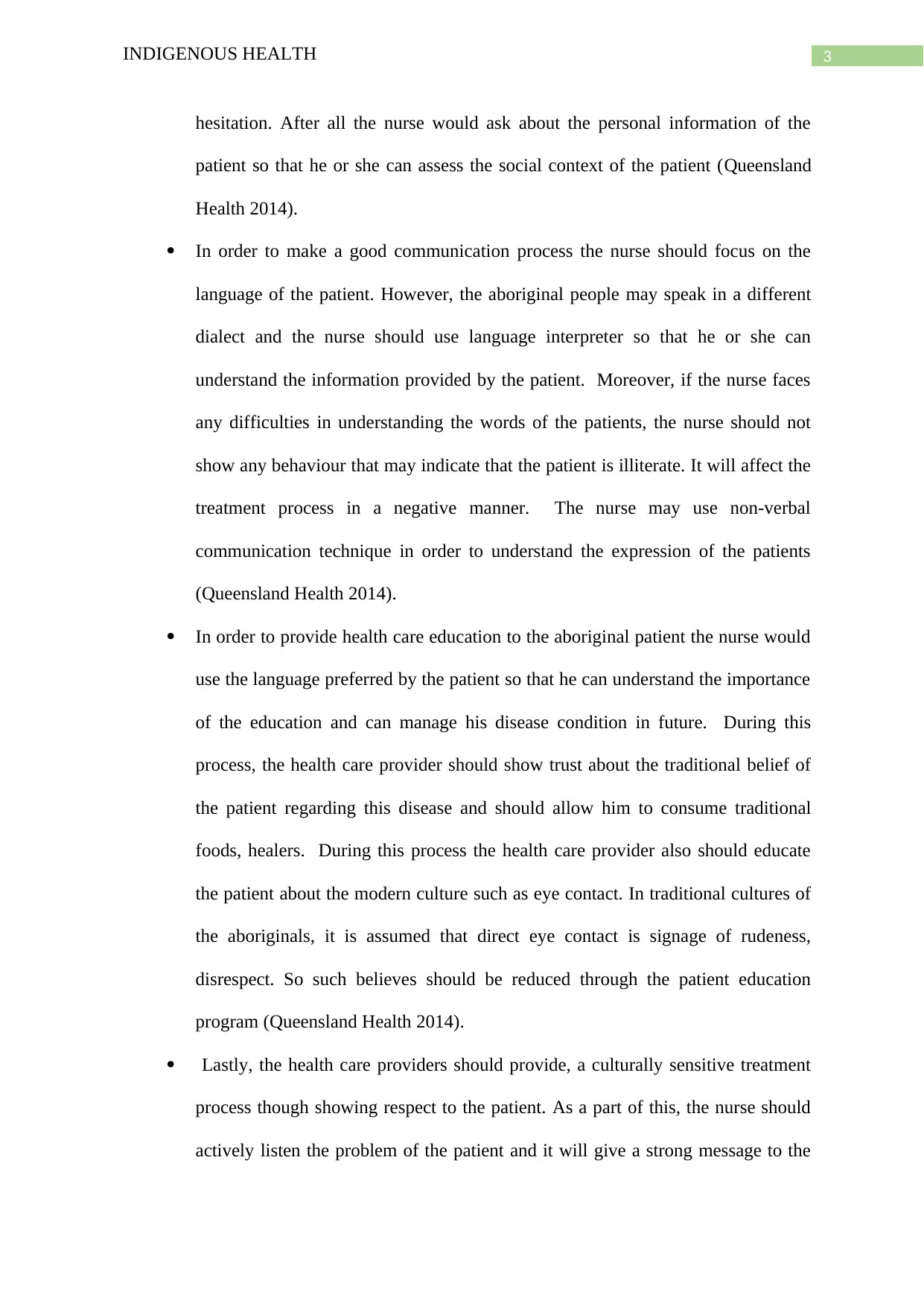
3INDIGENOUS HEALTH
hesitation. After all the nurse would ask about the personal information of the
patient so that he or she can assess the social context of the patient (Queensland
Health 2014).
In order to make a good communication process the nurse should focus on the
language of the patient. However, the aboriginal people may speak in a different
dialect and the nurse should use language interpreter so that he or she can
understand the information provided by the patient. Moreover, if the nurse faces
any difficulties in understanding the words of the patients, the nurse should not
show any behaviour that may indicate that the patient is illiterate. It will affect the
treatment process in a negative manner. The nurse may use non-verbal
communication technique in order to understand the expression of the patients
(Queensland Health 2014).
In order to provide health care education to the aboriginal patient the nurse would
use the language preferred by the patient so that he can understand the importance
of the education and can manage his disease condition in future. During this
process, the health care provider should show trust about the traditional belief of
the patient regarding this disease and should allow him to consume traditional
foods, healers. During this process the health care provider also should educate
the patient about the modern culture such as eye contact. In traditional cultures of
the aboriginals, it is assumed that direct eye contact is signage of rudeness,
disrespect. So such believes should be reduced through the patient education
program (Queensland Health 2014).
Lastly, the health care providers should provide, a culturally sensitive treatment
process though showing respect to the patient. As a part of this, the nurse should
actively listen the problem of the patient and it will give a strong message to the
hesitation. After all the nurse would ask about the personal information of the
patient so that he or she can assess the social context of the patient (Queensland
Health 2014).
In order to make a good communication process the nurse should focus on the
language of the patient. However, the aboriginal people may speak in a different
dialect and the nurse should use language interpreter so that he or she can
understand the information provided by the patient. Moreover, if the nurse faces
any difficulties in understanding the words of the patients, the nurse should not
show any behaviour that may indicate that the patient is illiterate. It will affect the
treatment process in a negative manner. The nurse may use non-verbal
communication technique in order to understand the expression of the patients
(Queensland Health 2014).
In order to provide health care education to the aboriginal patient the nurse would
use the language preferred by the patient so that he can understand the importance
of the education and can manage his disease condition in future. During this
process, the health care provider should show trust about the traditional belief of
the patient regarding this disease and should allow him to consume traditional
foods, healers. During this process the health care provider also should educate
the patient about the modern culture such as eye contact. In traditional cultures of
the aboriginals, it is assumed that direct eye contact is signage of rudeness,
disrespect. So such believes should be reduced through the patient education
program (Queensland Health 2014).
Lastly, the health care providers should provide, a culturally sensitive treatment
process though showing respect to the patient. As a part of this, the nurse should
actively listen the problem of the patient and it will give a strong message to the
Paraphrase This Document
Need a fresh take? Get an instant paraphrase of this document with our AI Paraphraser
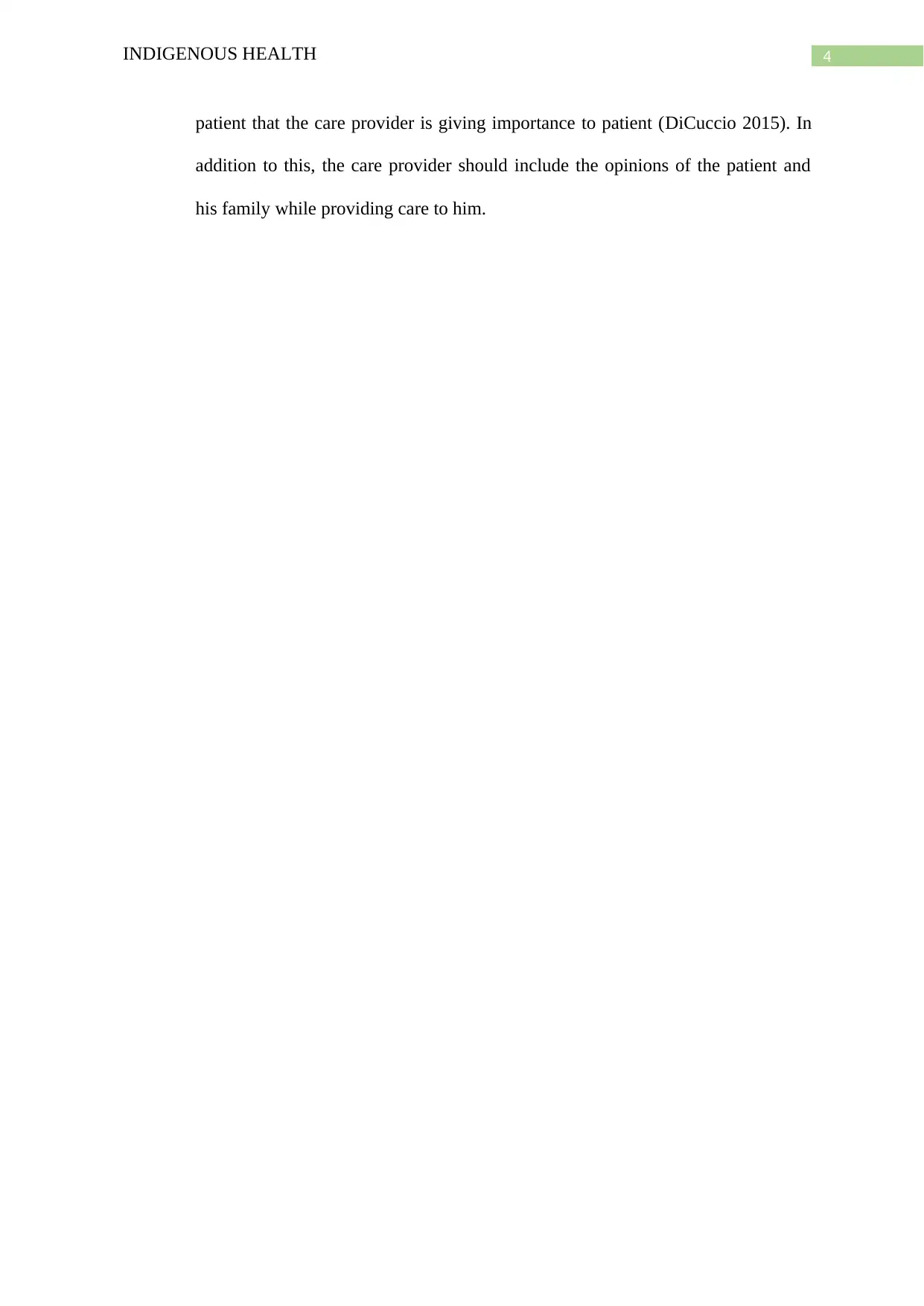
4INDIGENOUS HEALTH
patient that the care provider is giving importance to patient (DiCuccio 2015). In
addition to this, the care provider should include the opinions of the patient and
his family while providing care to him.
patient that the care provider is giving importance to patient (DiCuccio 2015). In
addition to this, the care provider should include the opinions of the patient and
his family while providing care to him.
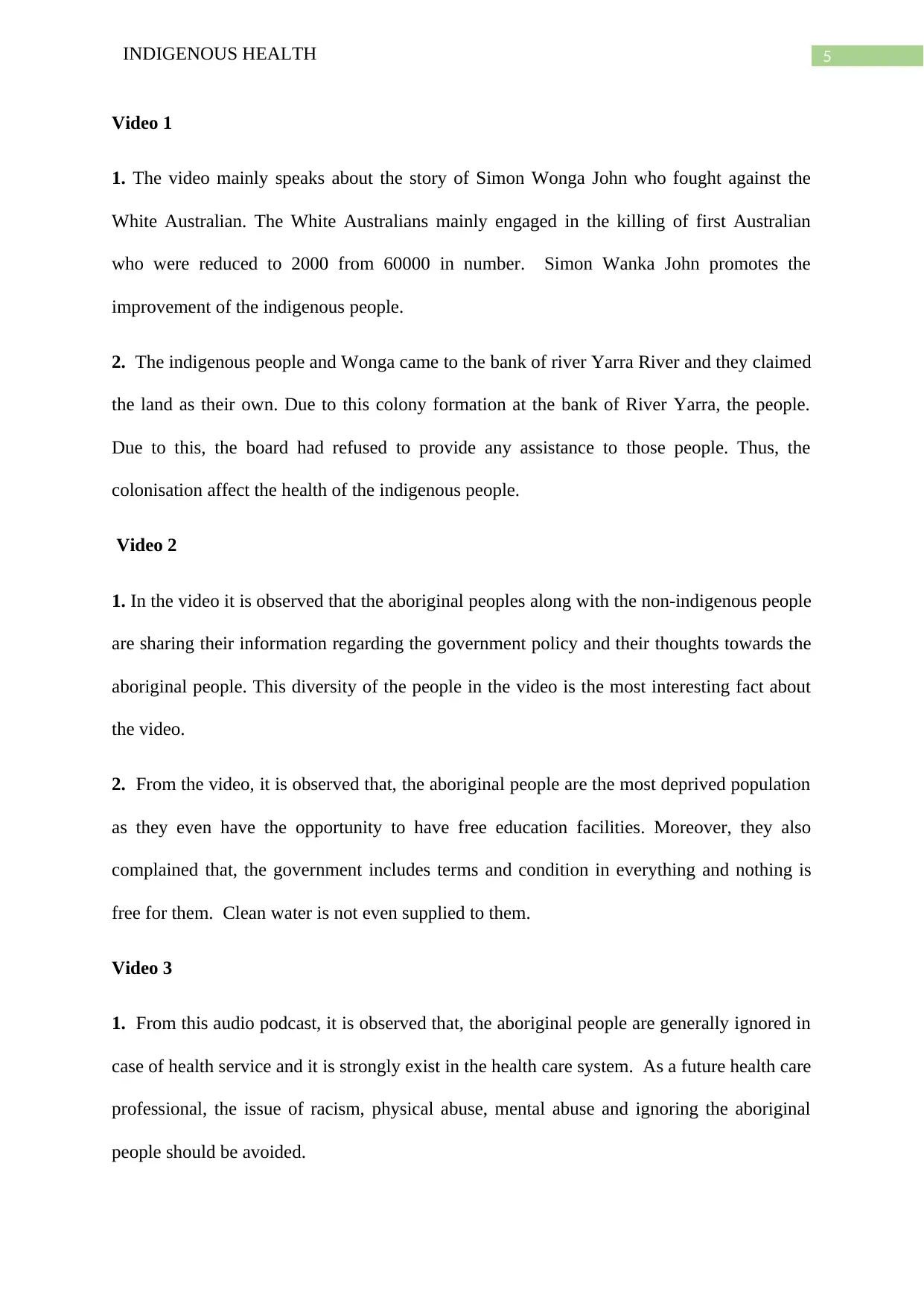
5INDIGENOUS HEALTH
Video 1
1. The video mainly speaks about the story of Simon Wonga John who fought against the
White Australian. The White Australians mainly engaged in the killing of first Australian
who were reduced to 2000 from 60000 in number. Simon Wanka John promotes the
improvement of the indigenous people.
2. The indigenous people and Wonga came to the bank of river Yarra River and they claimed
the land as their own. Due to this colony formation at the bank of River Yarra, the people.
Due to this, the board had refused to provide any assistance to those people. Thus, the
colonisation affect the health of the indigenous people.
Video 2
1. In the video it is observed that the aboriginal peoples along with the non-indigenous people
are sharing their information regarding the government policy and their thoughts towards the
aboriginal people. This diversity of the people in the video is the most interesting fact about
the video.
2. From the video, it is observed that, the aboriginal people are the most deprived population
as they even have the opportunity to have free education facilities. Moreover, they also
complained that, the government includes terms and condition in everything and nothing is
free for them. Clean water is not even supplied to them.
Video 3
1. From this audio podcast, it is observed that, the aboriginal people are generally ignored in
case of health service and it is strongly exist in the health care system. As a future health care
professional, the issue of racism, physical abuse, mental abuse and ignoring the aboriginal
people should be avoided.
Video 1
1. The video mainly speaks about the story of Simon Wonga John who fought against the
White Australian. The White Australians mainly engaged in the killing of first Australian
who were reduced to 2000 from 60000 in number. Simon Wanka John promotes the
improvement of the indigenous people.
2. The indigenous people and Wonga came to the bank of river Yarra River and they claimed
the land as their own. Due to this colony formation at the bank of River Yarra, the people.
Due to this, the board had refused to provide any assistance to those people. Thus, the
colonisation affect the health of the indigenous people.
Video 2
1. In the video it is observed that the aboriginal peoples along with the non-indigenous people
are sharing their information regarding the government policy and their thoughts towards the
aboriginal people. This diversity of the people in the video is the most interesting fact about
the video.
2. From the video, it is observed that, the aboriginal people are the most deprived population
as they even have the opportunity to have free education facilities. Moreover, they also
complained that, the government includes terms and condition in everything and nothing is
free for them. Clean water is not even supplied to them.
Video 3
1. From this audio podcast, it is observed that, the aboriginal people are generally ignored in
case of health service and it is strongly exist in the health care system. As a future health care
professional, the issue of racism, physical abuse, mental abuse and ignoring the aboriginal
people should be avoided.
⊘ This is a preview!⊘
Do you want full access?
Subscribe today to unlock all pages.

Trusted by 1+ million students worldwide
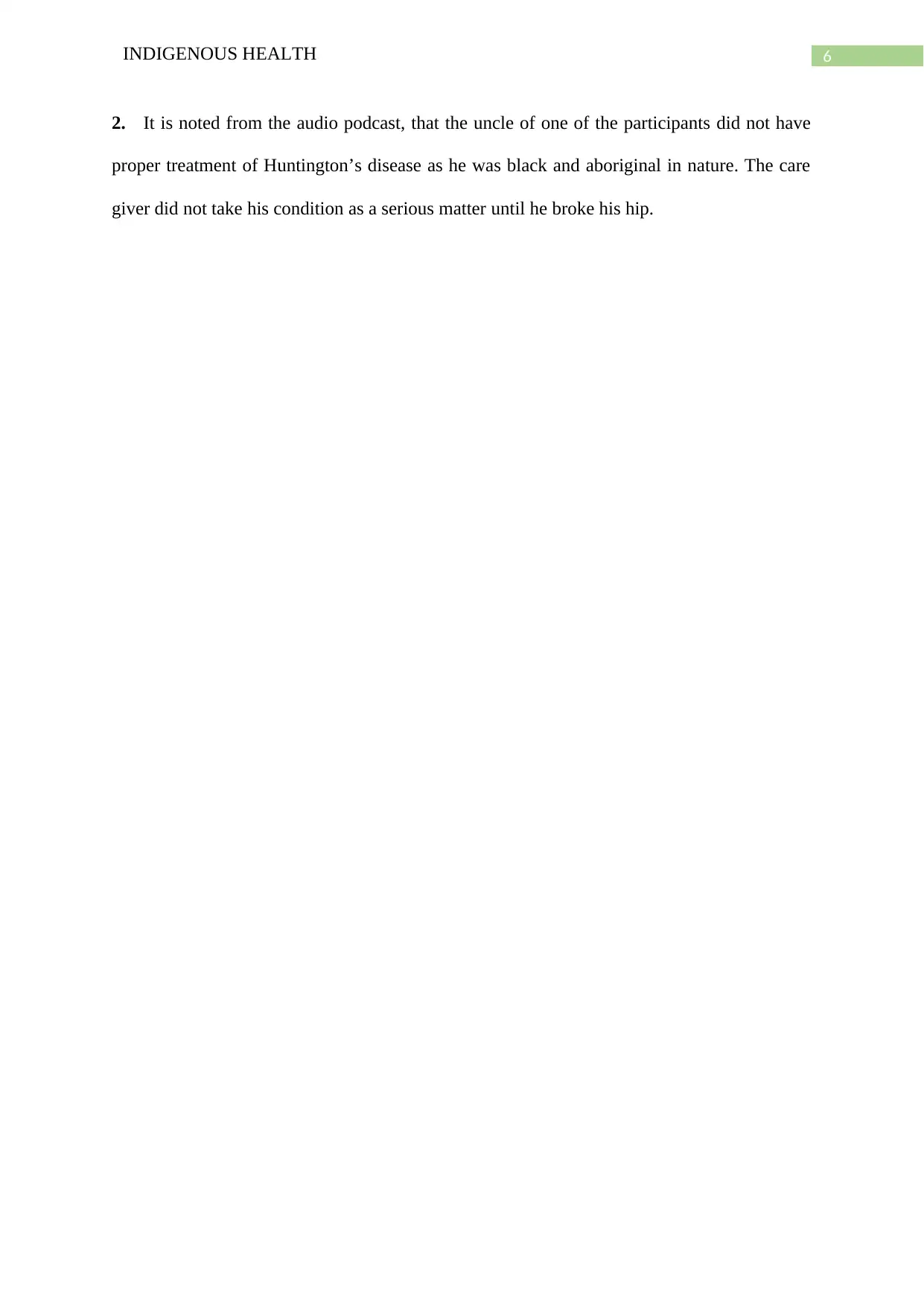
6INDIGENOUS HEALTH
2. It is noted from the audio podcast, that the uncle of one of the participants did not have
proper treatment of Huntington’s disease as he was black and aboriginal in nature. The care
giver did not take his condition as a serious matter until he broke his hip.
2. It is noted from the audio podcast, that the uncle of one of the participants did not have
proper treatment of Huntington’s disease as he was black and aboriginal in nature. The care
giver did not take his condition as a serious matter until he broke his hip.
Paraphrase This Document
Need a fresh take? Get an instant paraphrase of this document with our AI Paraphraser
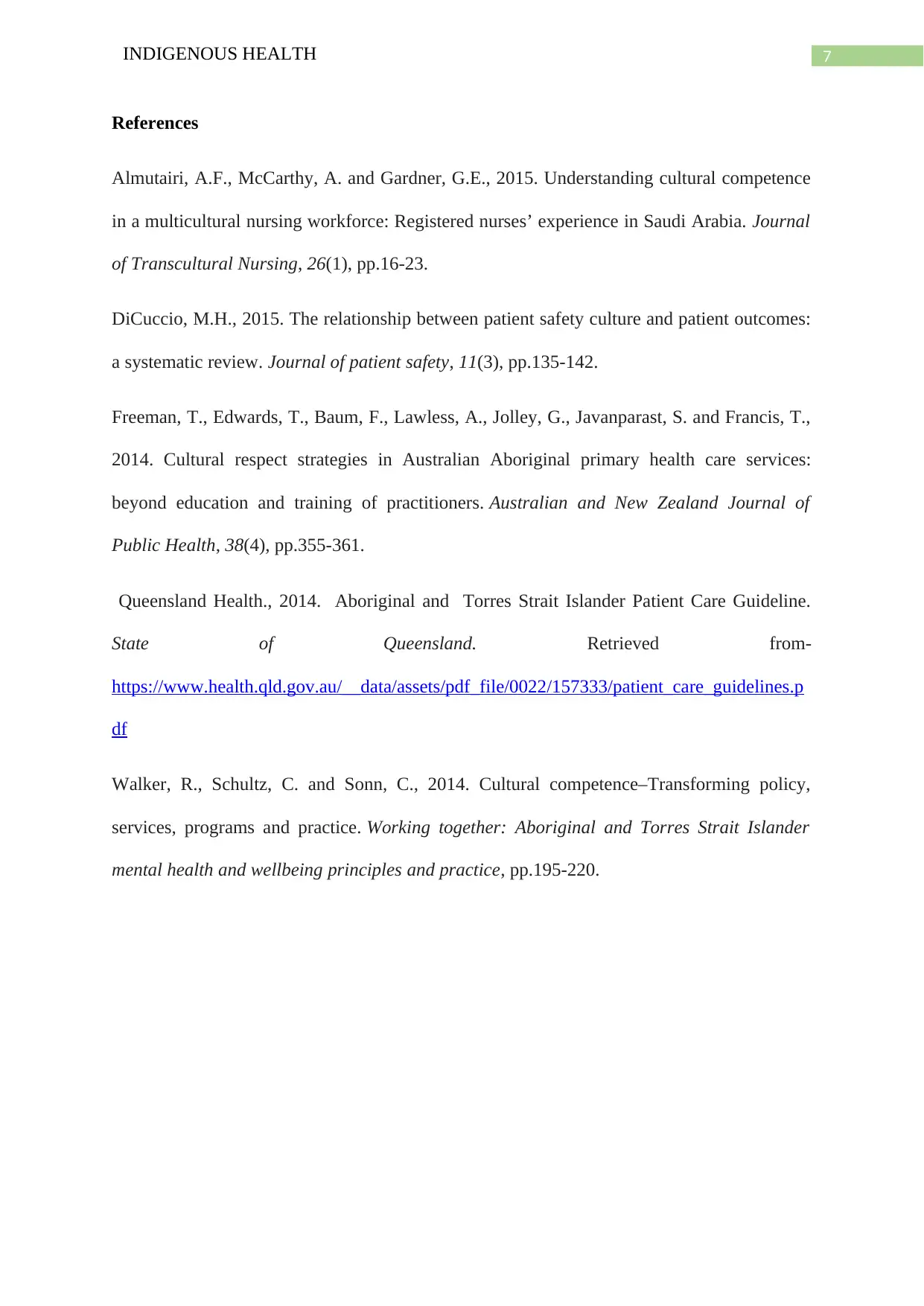
7INDIGENOUS HEALTH
References
Almutairi, A.F., McCarthy, A. and Gardner, G.E., 2015. Understanding cultural competence
in a multicultural nursing workforce: Registered nurses’ experience in Saudi Arabia. Journal
of Transcultural Nursing, 26(1), pp.16-23.
DiCuccio, M.H., 2015. The relationship between patient safety culture and patient outcomes:
a systematic review. Journal of patient safety, 11(3), pp.135-142.
Freeman, T., Edwards, T., Baum, F., Lawless, A., Jolley, G., Javanparast, S. and Francis, T.,
2014. Cultural respect strategies in Australian Aboriginal primary health care services:
beyond education and training of practitioners. Australian and New Zealand Journal of
Public Health, 38(4), pp.355-361.
Queensland Health., 2014. Aboriginal and Torres Strait Islander Patient Care Guideline.
State of Queensland. Retrieved from-
https://www.health.qld.gov.au/__data/assets/pdf_file/0022/157333/patient_care_guidelines.p
df
Walker, R., Schultz, C. and Sonn, C., 2014. Cultural competence–Transforming policy,
services, programs and practice. Working together: Aboriginal and Torres Strait Islander
mental health and wellbeing principles and practice, pp.195-220.
References
Almutairi, A.F., McCarthy, A. and Gardner, G.E., 2015. Understanding cultural competence
in a multicultural nursing workforce: Registered nurses’ experience in Saudi Arabia. Journal
of Transcultural Nursing, 26(1), pp.16-23.
DiCuccio, M.H., 2015. The relationship between patient safety culture and patient outcomes:
a systematic review. Journal of patient safety, 11(3), pp.135-142.
Freeman, T., Edwards, T., Baum, F., Lawless, A., Jolley, G., Javanparast, S. and Francis, T.,
2014. Cultural respect strategies in Australian Aboriginal primary health care services:
beyond education and training of practitioners. Australian and New Zealand Journal of
Public Health, 38(4), pp.355-361.
Queensland Health., 2014. Aboriginal and Torres Strait Islander Patient Care Guideline.
State of Queensland. Retrieved from-
https://www.health.qld.gov.au/__data/assets/pdf_file/0022/157333/patient_care_guidelines.p
df
Walker, R., Schultz, C. and Sonn, C., 2014. Cultural competence–Transforming policy,
services, programs and practice. Working together: Aboriginal and Torres Strait Islander
mental health and wellbeing principles and practice, pp.195-220.
1 out of 8
Related Documents
Your All-in-One AI-Powered Toolkit for Academic Success.
+13062052269
info@desklib.com
Available 24*7 on WhatsApp / Email
![[object Object]](/_next/static/media/star-bottom.7253800d.svg)
Unlock your academic potential
Copyright © 2020–2025 A2Z Services. All Rights Reserved. Developed and managed by ZUCOL.




